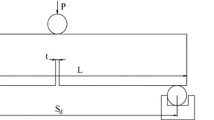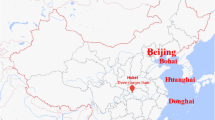Abstract
The mechanical parameters and deterioration mechanisms of sandstone specimens obtained from the hydrofluctuation belt in the Three Gorges Reservoir Region of China were investigated under a combination of freeze-thaw cycles and different chemical solutions. The degradation in several mechanical characteristics was discussed, and the degree of freeze-thaw deterioration of the mechanical behaviors was quantitatively analyzed based on the crack propagation radii and a damage variable that reflects the changes in porosity. The results showed that the mechanical parameters of sandstone had a significant damage deteriorating trend under freeze-thaw cycles and different chemical solutions. And the degree of damage deterioration of fracture toughness KIC was the greatest, followed by that of tensile strength; that of compression strength was the smallest. There was obvious consistency among fracture toughness KIC, tensile strength, and compression strength of sandstone under a combination of freeze-thaw cycles and different chemical solutions; those were obvious linear relationship. The crack propagation radii for the various effects of freeze-thaw cycles and chemical solutions were smaller than those of the natural state and the radii generally decreased with increasing freeze-thaw cycles.















Similar content being viewed by others
References
Akarli M, Prince W, Siddique R (2008) Damage in granite under heating/cooling cycles and water freeze-thaw condition. Int J Rock Mech Min Sci 45(7):1164–1175
Akin M, Özsan A (2011) Evaluation of the long-term durability of yellow travertine using accelerated weathering tests. Bull Eng Geol Environ 70:101–114
Ayatollahi MR, Aliha MRM (2007) Fracture toughness study for a brittle rock subjected to mixed mode I/II loading. Int J Rock Mech Min Sci 44:617–624
Bellanger M, Homand F, Remy JM (1993) Water behaviour in limestone as a function of pores structure: application to frost resistance of some Lorraine limestones. Eng Geol 36(l-2):99–108
Berto L, Saetta A, Talledo D (2015) Constitutive model of concrete damaged by freeze-thaw action for evaluation of structural performance of RC elements. Constr Build Mater 98:559–569
Bost M, Pouya A (2017) Stress generated by the freeze–thaw process in open cracks of rock walls: empirical model for tight limestone. Bull Eng Geol Environ 76(4):1491–1505
Bruno MS, Nakagawa FM (1991) Pore pressure influence on tensile fracture propagation in sedimentary rock. Int J Rock Mech Min Sci 28(4):261–273
Chen M, Zhang GQ (2004) Laboratory measurement and interpretation of the fracture toughness of formation rocks at great depth. J Pet Sci Eng 41:221–231
Chen M, Jin Y, Yuan CY (2001) Study on the experimental for fracture toughness under confining pressure. Mech Eng 23(4):32–35
Ciccotti M, Gonzato G, Mulargia F (2000) The double torsion loading configuration for fracture propagation: an improved methodology for the load-relaxation at constant displacement. Int J Rock Mech Min Sci 37(7):1103–1113
Cui ZD, Liu DA, An GM, Sun B, Zhou M, Cao FQ (2010) A comparison of two ISRM suggested chevron notched specimens for testing mode-I rock fracture toughness. Int J Rock Mech Min Sci 47:871–876
Dai F, Wei MD, Xu NW, Ma Y, Yang DS (2015) Numerical assessment of the progressive rock fracture mechanism of cracked chevron notched Brazilian disc specimens. Rock Mech Rock Eng 48:463–479
Dehghan AN, Goshtasbi K, Ahangari K, Jin Y (2015) Experimental investigation of hydraulic fracture propagation in fractured blocks. Bull Eng Geol Environ 74(3):887–895
Deng HF, Li JL, Sun XS, Zhu M, Yuan X, Luo Q (2012) Experimental research on fracture mechanical effect of sandstone under water corrosion. Chin J Rock Mech Eng 31(7):1342–1348
Dunning J, Douglas B, Miller M, Mcdonald S (1994) The role of the chemical environment in frictional deformation: stress corrosion cracking and comminution. Pure Appl Geophys 143(1/2/3):151–178
Erarslan N, Williams DJ (2012) The damage mechanism of rock fatigue and its relationship to the fracture toughness of rocks. Int J Rock Mech Min Sci 56:15–26
Feucht LJ, Logan M (1990) Effects of chemically active solutions on shearing behavior of a sandstone. Tectonophysics 175(1/2/3):159–176
Freiman SW (1984) Effects of chemical environments on slow crack growth in glasses and ceramics. J Geophys Res 89(B6):4072–4076
Ghobadi MH, Babazadeh R (2015) Experimental studies on the effects of cyclic freezing-thawing, salt crystallization, and thermal shock on the physical and mechanical characteristics of selected sandstones. Rock Mech Rock Eng 48:1001–1016
Golewski GL, Sadowski T (2017) The fracture toughness the KIIIc of concretes with F fly ash (FA) additive. Constr Build Mater 143:444–454
Golewski GL, Golewski P, Sadowski T (2012) Numerical modelling crack propagation under mode II fracture in plain concretes containing siliceous fly ash additive using XFEM method. Comput Mater Sci 62:75–78
Gong FY, Maekawa K (2018) Multi-scale simulation of freeze-thaw damage to RC column and its restoring force characteristics. Eng Struct 156:522–536
Gurocak Z, Kilic R (2005) Effect of weathering on the geomechanical properties of the Miocene basalts in Malatya, Eastern Turkey. Bull Eng Geol Environ 64:373–381
Inigo AC, Vicente MA, Rives V (2000) Weathering and decay of granitic rocks: its relation to their pore network. Mech Mater 32(9):555–560
Karfakis MG, Askram M (1993) Effect of chemical solutions on rock fracturing. Int J Rock Mech Min Sci Geomech Abstr 37(7):1253–1259
Laijtai EZ, Schmidtke RH, Bielus LP (1987) The effect of water on the time-dependent deformation and fracture of a granite. Int J Rock Mech Min Sci 24(4):247–255
Li Y, Zhou H, Zhang L, Zhu WS, Li SC, Liu J (2016) Experimental and numerical investigations on mechanical property and reinforcement effect of bolted jointed rock mass. Constr Build Mater 126:843–856
Mansourian A, Hashemi S, Aliha MRM (2018) Evaluation of pure and mixed modes (I/III) fracture toughness of Portland cement concrete mixtures containing reclaimed asphalt pavement. Constr Build Mater 178:10–18
Martinez-Martinez J, Benavente D, Gomez-Heraz M, Marco-Castano L (2013) Nonlinear decay of building stones during freeze-thaw weathering processes. Constr Build Mater 38:443–454
Momeni A, Abdilor Y, Khanlari GR, Heidari M, Sepahi AA (2016) The effect of freeze-thaw cycles on physical and mechanical properties of granitoid hard rocks. Bull Eng Geol Environ 75(4):1649–1656
Mutlutürk M, Altindag R, Türk G (2004) A decay function model for the integrity loss of rock when subjected to recurrent cycles of freezing-thawing and heating cooling. Int J Rock Mech Min Sci 41:237–244
Nicholson DT, Nicholson FH (2015) Physical deterioration of sedimentary rocks subjected to experimental freeze-thaw weathering. Earth Surf Process Landf 25(12):1295–1307
Palmer AN (1991) Origin and morphology of limestone caves. Geol Soc Am Bull 103:1–21
Park J, Hyun CU, Park HD (2015) Changes in microstructure and physical properties of rocks caused by artificial freeze-thaw action. Bull Eng Geol Environ 74(2):555–565
Piasta W, Góra J, Turkiewicz T (2016) Properties and durability of coarse igneous rock aggregates and concretes. Constr Build Mater 126:119–129
Reinhardt HW, Mielich O (2014) Fracture toughness of alkali-sensitive rocks in alkaline solution. Int J Rock Mech Min Sci 70:552–558
Rusin Z, Świercz P (2017) Frost resistance of rock materials. Constr Build Mater 148:704–714
Saadaoui M, Reynaud P, Fantozzi G (2000) Slow crack growth study of plaster using the double torsion method. Ceram Int 26(4):435–439
Seyed Mousavi SZ, Tavakoli H, Moarefvand P, Rezaei M (2019) Assessing the effect of freezing-thawing cycles on the results of the triaxial compressive strength test for calc-schist rock. Int J Rock Mech Min Sci 123:104090
Shah SE, Swartz SE, Ouyang C (1996) Fracture mechanics of concrete: applications of fracture mechanics to concrete, rock and other quasi-brittle materials. Eng Struct 18(11):887–888
Tan XJ, Chen WZ, Yang JP, Cao J (2011) Laboratory investigations on the mechanical properties degradation of granite under freeze–thaw cycles. Cold Reg Sci Technol 68:130–138
The Professional Standard Compilation Group of People’s Republic of China, DL/T5368–2007 Specifications for rock tests in water conservancy and hydroelectric engineering. China Water Power Press. (In Chinese)
Wang Y, Jia JS (2017) Experimental study on the influence of hydraulic fracturing on high concrete gravity dams. Constr Build Mater 132:508–517
Wang QZ, Feng F, Ni M, Gou XP (2011) Measurement of mode I and mode II rock dynamic fracture toughness with cracked straight through flattened Brazilian disc impacted by split Hopkinson pressure bar. Eng Fract Mech 78:2455–2469
Wang XE, Yang J, Liu QF, Zhang YM, Zhao CJ (2017) Experimental study on the influence of hydraulic fracturing on high concrete gravity dams. Constr Build Mater 152:493–505
Wang F, Cao P, Cao RH, Xiong XG, Hao J (2019) The influence of temperature and time on water-rock interactions based on the morphology of rock joint surfaces. Bull Eng Geol Environ 78(5):3385–3394
Wei MD, Dai F, Xu NW, Liu JF, Xu Y (2016) Experimental and numerical study on the cracked chevron notched semi-circular bend method for characterizing the mode I fracture toughness of rocks. Rock Mech Rock Eng 49:1595–1609
Wei MD, Dai F, Xu NW, Liu Y, Zhao T (2017a) Fracture prediction of rocks under mode I and mode II loading using the generalized maximum tangential strain criterion. Eng Fract Mech 186:21–38
Wei MD, Dai F, Xu NW, Zhao XT, Liu Y (2017b) An experimental and theoretical assessment of semi-circular bend specimens with chevron and straight-through notches for mode I fracture toughness testing of rocks. Int J Rock Mech Min Sci 99:28–38
Wei MD, Dai F, Xu NW, Liu Y, Zhao T (2018a) A novel chevron notched short rod bend method for measuring the mode I fracture toughness of rocks. Eng Fract Mech 190:1–15
Wei MD, Dai F, Zhou JW, Liu Y, Luo J (2018b) A further improved maximum tangential stress criterion for assessing mode I fracture of rocks considering non-singular stress terms of the Williams expansion. Rock Mech Rock Eng 51(11):3471–3488
Wu ZJ, Wong LNY (2014) Investigating the effects of micro-defects on the dynamic properties of rock using numerical manifold method. Constr Build Mater 72:72–82
Xu S, Li A, Ji Z, Wang Y (2016a) Seismic performance of reinforced concrete columns after freeze-thaw cycles. Constr Build Mater 102:861–871
Xu Y, Dai F, Xu NW, Zhao T (2016b) Numerical investigation of dynamic rock fracture toughness determination using a semi-circular bend specimen in split hopkinson pressure bar testing. Rock Mech Rock Eng 49:731–745
Yavuz H (2010) Effect of freeze-thaw and thermal shock weathering on the physical and mechanical properties of an andesite stone. Bull Eng Geol Environ 70:187–192
Yavuz H, Altindag R, Sarac S, Ugur I, Sengun N (2006) Estimating the index properties of deteriorated carbonate rocks due to freeze–thaw and thermal shock weathering. Int J Rock Mech Min Sci 43(5):767–775
Yehia NAB, Wahab NM (2007) Fracture mechanics of flanged reinforced concrete sections. Eng Struct 29:2334–2343
Yoshitaka N, Kazuya M, Naoki H, Tetsuro Y, Katsuhiko K, Benson PM (2012) Influence of relative humidity on fracture toughness of rock: implications for subcritical crack growth. Int J Solids Struct 49:2471–2481
Yu J, Chen X, Li H, Zhou JW, Cai YY (2015) Effect of freeze-thaw cycles on mechanical properties and permeability of red sandstone under triaxial compression. J Mt Sci 12(1):218–231
Zhang ZX (2002) An empirical relation between mode I fracture toughness and the tensile strength of rock. Int J Rock Mech Min Sci 39(3):401–406
Funding
The authors gratefully acknowledge the support by the National Natural Science Foundation of China (No. 51478272, 11302167, 11572244), the Science and Technology Foundation for the Basic Research Plan of Shenzhen City (JCYJ20160422095146121), and the Collaborative Innovation Research Centre for Environment-Friendly Materials and Structures in Civil Engineering, Southeast University.
Author information
Authors and Affiliations
Corresponding author
Rights and permissions
About this article
Cite this article
Han, T., Wang, X., Li, Z. et al. Laboratory investigation of the mode-I fracture of sandstone caused by a combination of freeze-thaw cycles and chemical solutions. Bull Eng Geol Environ 79, 3689–3706 (2020). https://doi.org/10.1007/s10064-020-01762-6
Received:
Accepted:
Published:
Issue Date:
DOI: https://doi.org/10.1007/s10064-020-01762-6




